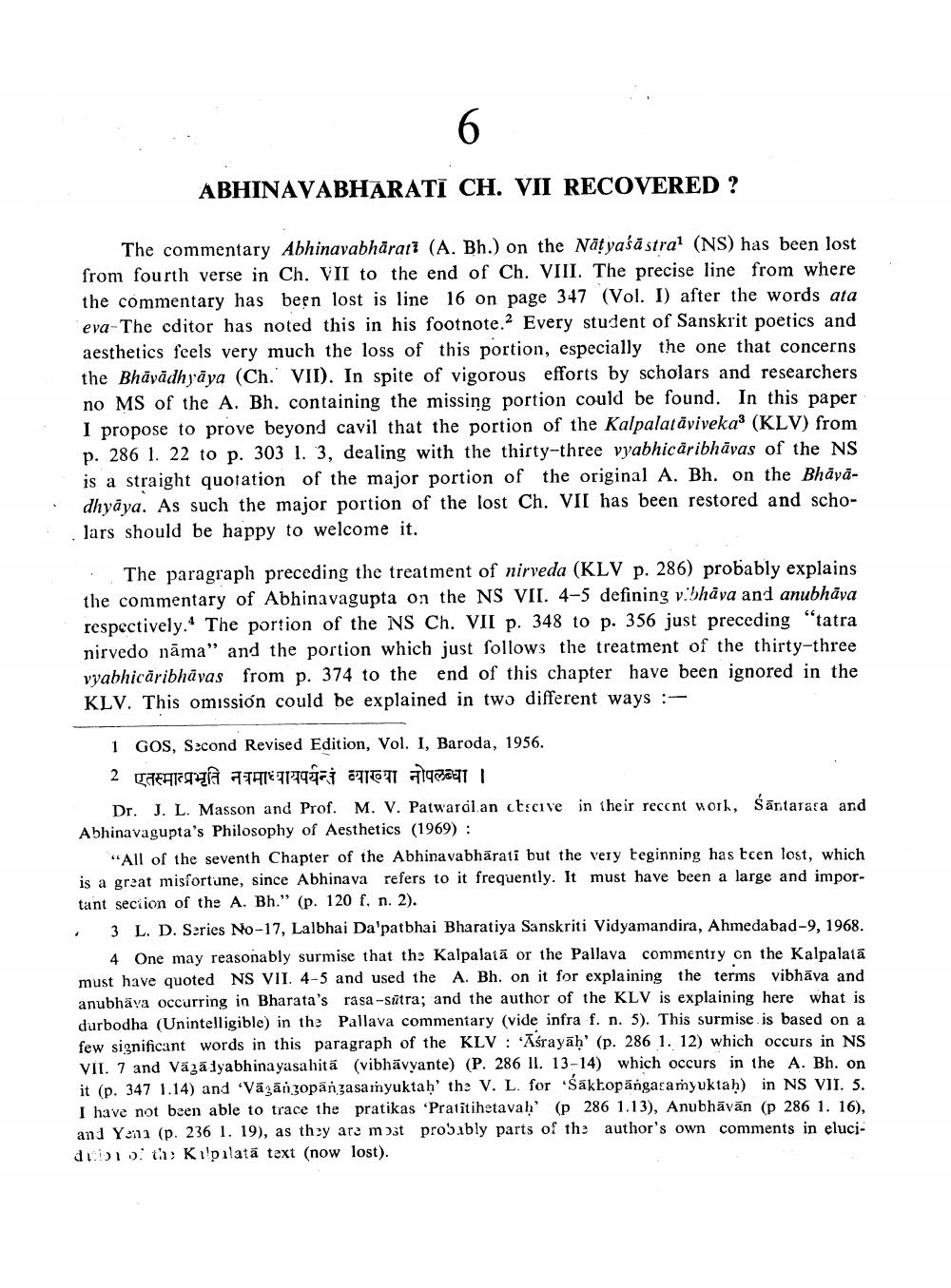________________
6
ABHINAVABHARATI CH. VII RECOVERED?
The commentary Abhinavabharat (A. Bh.) on the Natyalastra (NS) has been lost from fourth verse in Ch. VII to the end of Ch. VIII. The precise line from where the commentary has been lost is line 16 on page 347 (Vol. I) after the words ata eva-The editor has noted this in his footnote.2 Every student of Sanskrit poetics and aesthetics feels very much the loss of this portion, especially the one that concerns. the Bhavadhyaya (Ch. VII). In spite of vigorous efforts by scholars and researchers. no MS of the A. Bh. containing the missing portion could be found. In this paper I propose to prove beyond cavil that the portion of the Kalpalataviveka (KLV) from p. 286 1. 22 to p. 303 1. 3, dealing with the thirty-three vyabhicaribhavas of the NS is a straight quotation of the major portion of the original A. Bh. on the Bhavadhyaya. As such the major portion of the lost Ch. VII has been restored and scholars should be happy to welcome it.
The paragraph preceding the treatment of nirveda (KLV p. 286) probably explains. the commentary of Abhinavagupta on the NS VII. 4-5 defining v.bhava and anubhava respectively. The portion of the NS Ch. VII p. 348 to p. 356 just preceding "tatra nirvedo nama" and the portion which just follows the treatment of the thirty-three vyabhicaribhavas from p. 374 to the end of this chapter have been ignored in the KLV. This omission could be explained in two different ways:
1 GOS, Second Revised Edition, Vol. I, Baroda, 1956.
2 एतस्मात्प्रभृति नवमाध्यायपर्यन्तं व्याख्या नोपलब्धा ।
Dr. J. L. Masson and Prof. M. V. Patwardl an cbscive in their reccnt work, Santarata and Abhinavagupta's Philosophy of Aesthetics (1969):
"All of the seventh Chapter of the Abhinavabharati but the very beginning has been lost, which is a great misfortune, since Abhinava refers to it frequently. It must have been a large and important section of the A. Bh." (p. 120 f. n. 2).
3 L. D. Series No-17, Lalbhai Da'patbhai Bharatiya Sanskriti Vidyamandira, Ahmedabad-9, 1968.
4 One may reasonably surmise that the Kalpalata or the Pallava commentry on the Kalpalata must have quoted NS VII. 4-5 and used the A. Bh. on it for explaining the terms vibhāva and anubhava occurring in Bharata's rasa-sutra; and the author of the KLV is explaining here what is durbodha (Unintelligible) in the Pallava commentary (vide infra f. n. 5). This surmise is based on a few significant words in this paragraph of the KLV: Asrayah' (p. 286 1. 12) which occurs in NS VII. 7 and Vaga dyabhinayasahita (vibhavyante) (P. 286 II. 13-14) which occurs in the A. Bh. on it (p. 347 1.14) and 'Vaganzopangasamyuktaḥ' the V. L. for 'Sakkopangacamyuktaḥ) in NS VII. 5. I have not been able to trace the pratikas 'Pratitihetavaḥ' (p 286 1.13), Anubhavan (p 286 1. 16), and Yena (p. 236 1. 19), as they are most probably parts of the author's own comments in elucidubon of the Kilpilata text (now lost).




